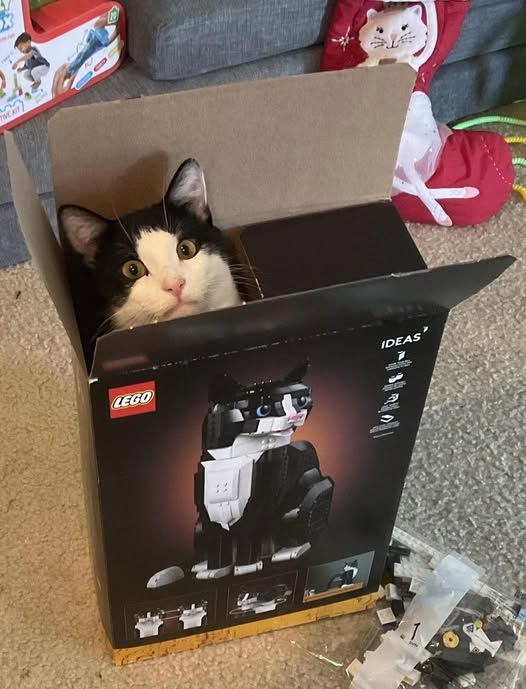This One Came Pre-Assembled: A Tale of Curiosity, Cardboard, and Cat Logic

This One Came Pre-Assembled: A Tale of Curiosity, Cardboard, and Cat Logic
There are moments in life that defy logic, defy planning, and instead deliver pure, spontaneous joy — the kind that sneaks up on you when you least expect it. For me, one of those moments arrived wrapped not in grand gestures, but in a cardboard box. More precisely, a LEGO box. I had been looking forward to a quiet weekend indoors. A break from the bustle of the outside world. My plan was simple: open up the new LEGO Ideas “Tuxedo Cat” set I had ordered online, brew a cup of tea, and enjoy the simple, meditative pleasure of clicking thousands of small bricks into a recognizable form. I had seen the pictures online — a cute black-and-white cat, upright and expressive, made of plastic and personality. But the real surprise wasn’t in the box’s contents. It was who ended up inside.
Before I even had a chance to slice open the seal, my own cat — Oreo — had already staked his claim. One moment the box was untouched on the carpet, the next, it was a feline fortress. Oreo, with his signature tuxedo markings and oversized eyes, had climbed in like he belonged there. As if the box wasn’t a LEGO set at all, but a throne custom-made just for him. I stood there, box cutter in hand, watching my very real cat sit proudly inside a cardboard home meant for a toy cat that looked suspiciously like him. And in that moment, with his ears poking over the edge and his face peeking out as if he’d been shipped by the LEGO factory itself, all I could think was: “This one came pre-assembled.”

The timing was too perfect. The resemblance was uncanny. The humor was undeniable. Oreo didn’t just sit in the box — he became the box. His expression, wide-eyed and oddly smug, suggested he knew exactly what he was doing. Like he was in on the joke. Like he was saying, “Why settle for plastic when you have the real thing?” And truly, he had a point.
Now, Oreo has always had a peculiar fascination with boxes. It doesn’t matter the size, shape, or material. If there is a box in our home, Oreo will find it, claim it, and sit in it like it’s his birthright. I once caught him sleeping inside a tissue box, with only his head and tail poking out like a furry sandwich. I’ve seen him cram himself into shoe boxes half his size, balancing awkwardly but proudly, as though completing some invisible feline challenge. But this LEGO box incident surpassed them all. It wasn’t just funny — it was poetic. It was a moment where reality and imagination collided, where my love for tiny toys met the chaotic logic of a cat’s curiosity.
I abandoned my original plan. There would be no peaceful, uninterrupted LEGO building that afternoon. Oreo had declared the box occupied. And rather than evict him, I sat beside the box and laughed. Eventually, I opened the box from the side, pulling out the carefully organized bags of bricks while Oreo remained perched in the top flap like a living mascot. Every now and then, he would glance down, watching me lay out the instructions, paw at a brick, or bat gently at a LEGO cat ear I had just assembled. He supervised the entire process, adding an unexpected level of difficulty — and entertainment — to the build. It was as if I wasn’t just building a model anymore. I was building beside a muse. A mentor. A meow-ster, if you will.

The LEGO build took much longer than anticipated. With Oreo’s paws occasionally resting on critical instruction pages, and his tail sweeping across the floor like a wrecking ball, progress was slow. But it didn’t matter. In fact, I welcomed the slowness. There was something comforting about the quiet, the rhythm of snapping bricks together, and the company of a cat who had no idea how much joy he was bringing. Or maybe he did. Cats are clever like that — mysterious, aloof, yet deeply intuitive when it counts.
As I continued building, I found myself reflecting on the strange, beautiful relationship between cats and boxes. Scientists have tried to explain it. Some say boxes provide a sense of security — a cozy, enclosed space that mimics the feeling of a safe den. Others point to temperature regulation, as cardboard can trap heat. Then there’s the theory about territory — that cats sit in boxes to claim them, leaving behind their scent as a form of ownership. But I think the truth is simpler: cats sit in boxes because they can. Because it’s funny. Because it confuses humans. Because, in a world full of rules and expectations, a box is a place where they make their own. A tiny kingdom. A stage. A joke. A home.

Oreo certainly saw the LEGO box that way. And every time I looked up from the instruction booklet to see his eyes peering at me from behind a cardboard wall, I felt lighter. Happier. In a world that often moves too fast, Oreo forced me to slow down. To laugh. To notice the small things — like how his black nose twitched when I rattled a bag of bricks, or how he looked mildly offended when I accidentally dropped a LEGO tail on his head. We spent the whole weekend like that: him in the box, me on the floor, building something both simple and profound.
When I finally completed the LEGO cat, I placed it on the shelf — not too high, so Oreo could see it. He sniffed it once, pawed it lightly, then sat beside it as if to say, “Not bad. But I’m still the original.” And he was right. The plastic version was charming — carefully designed, expressive, clever in its build. But it lacked the warmth, the unpredictability, the spirit of the real thing. Oreo, in all his box-loving glory, was art and artist, subject and inspiration.
Since then, the LEGO box has remained in our living room. I’ve tried to throw it away multiple times, only to find Oreo asleep inside, his body curled into the corners like liquid fur. I’ve given up. The box stays. It has become a monument, a shared memory, a snapshot of a weekend where nothing extraordinary happened — and yet everything did.

Friends who visit our home now recognize the story immediately. They see the LEGO cat on the shelf, then turn to the box on the floor with Oreo inside, and smile. Some take pictures. Others ask if it’s staged. But most just laugh, because the scene is undeniably, irresistibly perfect. A box meant for a toy cat, claimed by the real cat it accidentally resembles. A model meant to bring joy, upstaged by a living version who did it better without trying.
And that’s the magic of cats. They don’t need instructions. They don’t follow steps. They don’t come with guarantees or warranties. But they bring a kind of unpredictable delight that no factory-set product ever could. They remind us that the best things in life are often unplanned, unscripted, and wrapped in cardboard.
So yes, this one came pre-assembled. And no, I wouldn’t trade him for a thousand LEGO sets.










